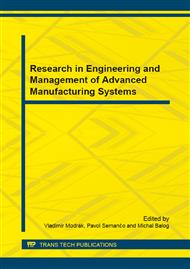[1]
M. Benes, Competition and competitive advantage, Research Centre for Competitiveness of the Czech Economy, 5(2006).
Google Scholar
[2]
Ö. Sőlvell, C. Ketels, G. Lindqvist, The European Cluster Observatory – EU Cluster Mapping and Strengthening Clusters in Europe, Europe INNOVA Paper, (2009).
Google Scholar
[3]
M. Balog, Cluster policy in the context of the knowledge economy. Disertation thesis. Bratislava (2014).
Google Scholar
[4]
M. E. Porter, Location, Competition, and Economic Development: Local Cllus in a Global Economy, Economic Development Quarterly, 14(2000), 15 – 34.
DOI: 10.1177/089124240001400105
Google Scholar
[5]
M. S. Dahl, C. R. Pedersen, Knowledge Flows Through Informal Contacts in Industrial Clusters: Myth or Reality?, Research Policy, 33(2004) 1673 – 1686.
DOI: 10.1016/j.respol.2004.10.004
Google Scholar
[6]
A. Jaffe, Real Effects of Academic Research. American Economic Review, 79(1989) 957 – 970.
Google Scholar
[7]
S. Ferencikova, M. Fifekova, Effects of spillovers from the effects of foreign companies in Slovakia. Journal of Economics, 56(2008) 855 – 872.
Google Scholar
[8]
EC: The Concept of Clusters and Cluster Policies and Their Role for Competitiveness and Innovation. Statistical Results and Lesson Learned. Commission Staff Working Document SEC (2008).
Google Scholar
[9]
C. Ketels, G. Lindqvist, Ö. Sőlvell, Strengthening Clusters and Competitiveness in Europe. The Role of Cluster Organisations, The Cluster Observatory, (2012).
Google Scholar
[10]
M. Bucek,: Regional development - recent theoretical concepts. Bratislava: Publishing Ekonom, Slovakia. (2006).
Google Scholar
[11]
Folta, T. B. et al.: Geographic Cluster Size and Firm Performance. Journal of Business Venturing, No. 2, p.217 – 242. (2006).
DOI: 10.1016/j.jbusvent.2005.04.005
Google Scholar
[12]
Baptista R., Swann, P.: Do Firms in Clusters Innovate More? Research Policy, 27, No. 5, p.525 – 540. (1998).
DOI: 10.1016/s0048-7333(98)00065-1
Google Scholar
[13]
Iammarino, S., Mccann, P.: The Structure and Evolution of Industrial Clusters: Transactions, Technology and Knowledge Spillovers. Research Policy, 35, No. 7, pp.1018-1036. (2006).
DOI: 10.1016/j.respol.2006.05.004
Google Scholar
[14]
Engel, J. S., del-Palacio, I.: Global Networks of Clusters of Innovation: Accelerating the Innovation Process. Business Horizons, 52, č. 5, s. 493 – 503. (2009).
DOI: 10.1016/j.bushor.2009.06.001
Google Scholar


